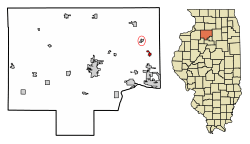Cherry, Illinois
Cherry is a village in Bureau County, Illinois, United States. The population was 482 at the 2010 census.[3] It is part of the Ottawa Micropolitan Statistical Area. It is located northwest of LaSalle-Peru, just a few miles north of Interstate 80, and is about 75 miles (121 km) east of the Quad Cities.
Cherry, Illinois | |
|---|---|
Village | |
 Location of Cherry in Bureau County, Illinois. | |
.svg.png) Location of Illinois in the United States | |
| Coordinates: 41°25′36″N 89°12′45″W | |
| Country | United States |
| State | Illinois |
| County | Bureau |
| Township | Westfield |
| Area | |
| • Total | 0.52 sq mi (1.34 km2) |
| • Land | 0.52 sq mi (1.34 km2) |
| • Water | 0.00 sq mi (0.00 km2) 0% |
| Population (2010) | |
| • Total | 482 |
| • Estimate (2019)[2] | 453 |
| • Density | 877.91/sq mi (339.15/km2) |
| Time zone | UTC-6 (CST) |
| • Summer (DST) | UTC-5 (CDT) |
| ZIP Code(s) | 61317 |
| Area code(s) | 815 & 779 |
| FIPS code | 17-12970 |
| Wikimedia Commons | Cherry, Illinois |
Cherry was the site of the Cherry Mine Disaster, which killed 259 coal miners in November 1909. This was the third most deadly mine disaster in U.S. history (as of 2005).[4]
History
The St. Paul Coal Company sank a shaft at the Cherry Mine in 1905. The mine supplied coal for Chicago, Milwaukee and St. Paul Railroad locomotives, and was named for the first mine superintendent, James Cherry. The Cherry Mine Disaster occurred in 1909, and remains one of the worst coal mining disasters in United States history. The disaster led to changes in US and Illinois mining and labor regulations, as well as enforced of child labor laws and the requirement in Illinois that mines have fire fighting equipment and more fireproof materials. Cherry Coal Company took over operations from 1929 until 1935 when it closed.[5]
Geography
According to the 2010 census, Cherry has a total area of 0.53 square miles (1.37 km2), all land.[6]
Demographics
| Historical population | |||
|---|---|---|---|
| Census | Pop. | %± | |
| 1910 | 1,048 | — | |
| 1920 | 1,265 | 20.7% | |
| 1930 | 636 | −49.7% | |
| 1940 | 583 | −8.3% | |
| 1950 | 520 | −10.8% | |
| 1960 | 501 | −3.7% | |
| 1970 | 551 | 10.0% | |
| 1980 | 541 | −1.8% | |
| 1990 | 487 | −10.0% | |
| 2000 | 509 | 4.5% | |
| 2010 | 482 | −5.3% | |
| Est. 2019 | 453 | [2] | −6.0% |
| U.S. Decennial Census[7] | |||
As of the census[8] of 2000, there were 509 people, 212 households, and 146 families residing in the village. The population density was 946.0 people per square mile (363.9/km2). There were 220 housing units at an average density of 408.9 per square mile (157.3/km2). The racial makeup of the village was 97.45% White, 0.20% African American, 0.39% Native American, 0.39% Pacific Islander, 0.39% from other races, and 1.18% from two or more races. Hispanic or Latino of any race were 1.77% of the population.
There were 212 households out of which 31.6% had children under the age of 18 living with them, 57.5% were married couples living together, 8.5% had a female householder with no husband present, and 30.7% were non-families. 28.3% of all households were made up of individuals and 14.6% had someone living alone who was 65 years of age or older. The average household size was 2.40 and the average family size was 2.93.
In the village, the population was spread out with 24.0% under the age of 18, 5.3% from 18 to 24, 30.5% from 25 to 44, 24.2% from 45 to 64, and 16.1% who were 65 years of age or older. The median age was 40 years. For every 100 females, there were 89.2 males. For every 100 females age 18 and over, there were 90.6 males.
The median income for a household in the village was $41,591, and the median income for a family was $48,438. Males had a median income of $34,375 versus $22,813 for females. The per capita income for the village was $19,313. None of the families and 1.8% of the population were living below the poverty line, including no under eighteens and 5.5% of those over 64.
References
- "2019 U.S. Gazetteer Files". United States Census Bureau. Retrieved July 14, 2020.
- "Population and Housing Unit Estimates". United States Census Bureau. May 24, 2020. Retrieved May 27, 2020.
- "Geographic Identifiers: 2010 Demographic Profile Data (G001): Cherry village, Illinois". U.S. Census Bureau, American Factfinder. Archived from the original on February 12, 2020. Retrieved November 14, 2013.
- "Historical Mine Disasters". www.cdc.gov. Retrieved 2016-02-17.
- Piacenti, Jim (2011). The Promise of a Better Life: The Coal Mines of Eastern Bureau County, Illinois. Ladd, Illinois: Locust Street Publishing. pp. 144–178.
- "G001 - Geographic Identifiers - 2010 Census Summary File 1". United States Census Bureau. Archived from the original on 2020-02-13. Retrieved 2015-08-02.
- "Census of Population and Housing". Census.gov. Retrieved June 4, 2015.
- "U.S. Census website". United States Census Bureau. Retrieved 2008-01-31.
External links
